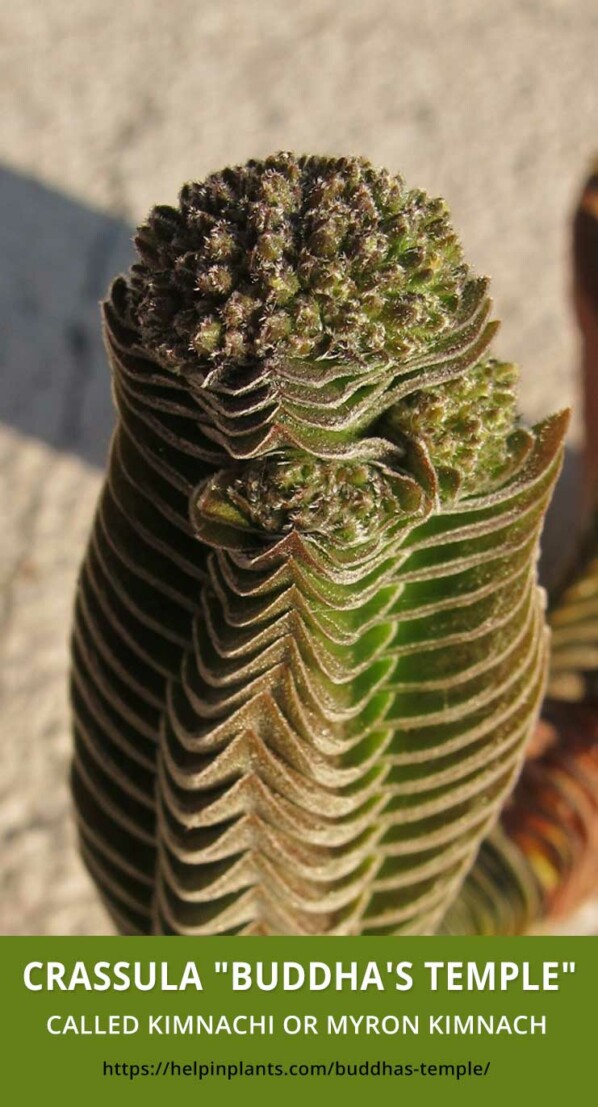Crassula 'Kimnachi', Crassula 'Myron Kimnach'
Crassula Buddha's Temple Succulent
Crassula "Buddha's Temple" is a beautiful succulent plant that grows to a height of about 15 cm. Its leaves are thin, flat, and soft, having a silver-grey to gray-green color. It grows in columns and usually, every column grows many other branches. The leaves stack tightly with each other, folded upward at the edges, which makes a perfect square. The diameter of this square can grow up to 1 inch.
At the top of these beautiful leaves columns, it produces orange, pink, red, or white flowers as well. You'll love it in your garden with large stones.
Details about Crassula Buddha's Temple Succulent "Crassula 'Kimnachi', Crassula 'Myron Kimnach'"
How to care for Crassula Buddha's Temple?
The whole Crassuloideae genus is easy to care for. But it suffers from mealybugs and fungal diseases. So whenever you cut any section, treat it with fungicide.
Crassula “Buddha's Temple” plant is known to be a man-made hybrid of Crassula pyramidalis and Crassula perfoliata var minor. It is a light-loving plant. So place it where it gets full sun. It grows to its most vibrant colors when it gets enough sunlight.
Where should you plant this succulent?
If you live in a colder environment, where temperature can go below 25 °F (-3.9 °C), You should plant Crassula “Buddha's Temple” in a container. While planting, use DIY Succulent Soil for the pot, OR get the best succulents soil pre-mixed.
As it is not cold hardy (hardiness zone 9b), you'll be able to bring it inside in winter if it is in a pot.
Consider its light requirement too. This succulent needs more sunlight. So plant where it gets about 5-6 hours of direct sunlight a day.
Watering Crassula Buddha's Temple Plant
Crassula “Buddha's Temple” does not require any special watering schedule. You can use the same succulents watering method just like for other succulents plants. It is best to water when the soil is completely dry. Otherwise, its roots may rot in wet soil or produce a weak root system.
This plant is a slow-growing succulent and has a powdery coating over it that can be washed away with watering or rubbing. So water only below lower leaves to avoid losing these coating.
Blooming Season for Crassula Buddha's Temple

The Crassula buddha's temple flower from late winter to early spring. It produces beautiful blooms of spherical crimson, orange, or white flowers that turn vivid pink with time.
Feed fortnightly with a balanced liquid fertilizer before the blooming season to encourage flowers growth.
How to Propagate Crassula Buddha's Temple?
Crassula “Buddha's Temple” can be propagated by division, offsets, leaf cuttings, and even seeds. Propagating by offsets and leaf cuttings might be perfect for beginners, as it is easier.
Check succulents propagation ultimate guide for more info.
Propagate by Division
To propagate Crassula “Buddha's Temple” by division, simply dig up the plant and divide it gently into separate parts. Repot the parts in well-draining succulents soil.
Remember to give water when the soil is completely dry. Check out the last section for watering babies in the watering succulents guide.
Propagate by Offsets
Crassula Buddha's Temple produces small offsets around its base. Simply pull these offsets and plant them in well-draining soil.
Use the soak and dry method, i.e. give water when the soil is fully dry. Then wait a few days before repeating the process. I have mentioned that at the last in the watering succulent guide.
Propagate by Leaf cuttings
When cutting a leaf for propagation, try to gently cut as a whole. I.e. no part of the leaf should be left on the stem. This will increase your chances of successful propagation.
After collecting leaves, callous over for a day or two. Then place the leaves on well-draining soil, and start misting them when they are dry.
During succulents propagation, they need to be misted more often, i.e. about twice a day at normal room temperature.
Propagating by Seeds.
Crassula buddha's temple can be propagated by seeds, but it is usually difficult. Because it is hard to germinate its seeds. To propagate by seeds, simply sow them in nutrients rich succulents and cacti soil during spring or summer. If your climate is cooler, do it indoors.
Check the ultimate guide for growing and caring for succulents indoors.
Fertilizing Crassula Buddha's Temple
In its active growing season, i.e. in Spring, you should give some organic fertilizer to boost its growth. To encourage flowering, feed it before the blooming season start.
When to repot the Crassula Buddha's Temple?
Generally, it is good to repot your indoor plants in a year or two. For the Crassula Buddha's Temple succulent, you should repot it at the beginning of its active growing season. I.e. At the start of the Spring season.
Check out my other guide for successfully planting succulents in pots, ground, or container gardens.
Where to Buy Crassula Buddha's Temple?
Crassula Buddha's Temple is available on the following succulent source:
Pairs Well With
- Haworthia concolor
- Crassula Moonglow
Crassula Buddha's Temple video
An interesting video from a YouTuber "Alex" about growing and caring for Crassula Buddha's temple succulent. It is worth watching.
Image Credit: Crassulaceae.ch
Facts & Features
-
3 Propagation Types
Propagation can be done by division, offsets, and leaf cuttings.
-
6 inches Tall
This plant grows up to 6″ (15 cm) tall
-
Grows in spring and summer
Need more care during these times.
-
Indoors Lit Area
Better to keep it near a window where it gets enough sunlight. OR, keep it outdoors.
-
Normal Watering
Use regular succulent watering methods. Learn how to water succulents easily.
-
Not Cold Hardy
Protect from very low temperatures.
-
Partially Shady Sunlight
You can keep it in full sun but protect it during the afternoon.
-
Toxic to Pets
Try protecting your pets from consuming this plant.
-
Zone 9b
In this zone, the temperature can drop up to 25° F ( -3.9° C )

